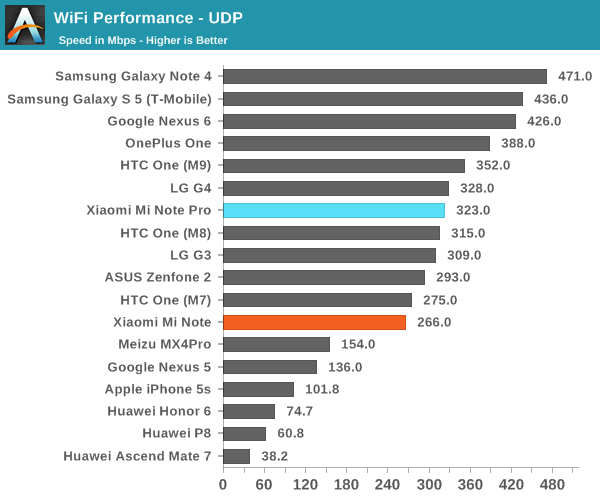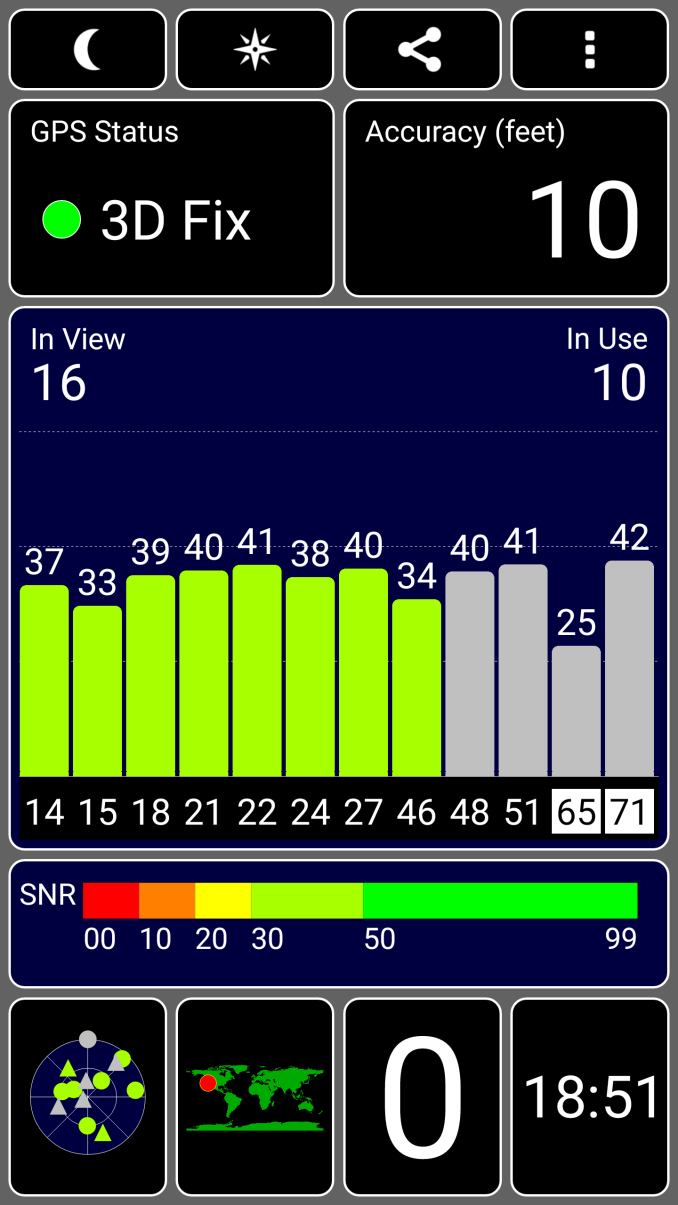The Xiaomi Mi Note Pro and Mi Note Review
by Joshua Ho on September 11, 2015 9:00 AM ESTWiFi Performance
Even though smartphones are usually considered to be necessary for their mobile data capabilities, smartphones and tablets tend to spend a lot of time on WiFi networks instead. As a result, it’s important to have a smartphone with good WiFi connectivity as otherwise there’s potential for poor bandwidth, connection reliability, and frequent drop-outs from a router. Anyone that has tried a smartphone with poor WiFi will probably understand just how frustrating all of these things can be. In order to try and approach testing a complex radio subsystem, we’ve settled for a relatively simple bandwidth test using iPerf to see what the maximum UDP download rate is on the device under test. In the case of the Xiaomi Mi Note, we see a Qualcomm Atheros WCN3680 WiFi chipset, and the Mi Note Pro appears to use a QCA6174 despite only enabling a single spatial stream.

Interestingly, the Mi Note Pro ends up with a higher peak bandwidth result than the Mi Note even though both are using a single spatial stream. I’m not sure what’s causing this, as performance between the two should be relatively as the main performance improvement from QCA6174 should be dual spatial stream 802.11ac. Either way, neither should have significant problems in everyday use of WiFi given dual band support and support for the latest standards.
GNSS
Location services are surprisingly important in a smartphone. Without highly accurate, reliable, and fast location fixes a number of applications in a smartphone would be difficult if not impossible to implement. Turn by turn navigation is easily one of the most common and critical location-based applications a phone will run, and poor GNSS performance is a good way to make sure it never gets used. In order to test this, we run a standard GPS information application and attempt to accurately track just how fast it takes for a phone to acquire a lock without any GPS assistance (airplane mode) and no pre-existing assistance data. In the case of the Xiaomi Mi Note phones, the GNSS solution is likely to be integrated into Qualcomm’s modem, which means that with any kind of mobile data connection time to first lock is on the order of 5 seconds.
Running the test previously described, the Mi Note line appears to achieve first lock in roughly 40 seconds, and almost immediately after first lock is acquired accuracy is at 10 feet. It’s actually quite rare for a phone to achieve this, as most phones usually take at least an extra 10-30 seconds to get down to usable accuracy levels once first lock is achieved. Received signal strength is quite strong with most satellites strongly in the 30 dB SNR range.
Misc
While we don't really have the necessary equipment to do audio right, I noticed a number of things on the Mi Note series that seems to set the Mi Note line apart from other phones I've tested recently in audio performance. The first thing worth noting is that the speaker gets painfully loud, to the point where I usually keep volume under half of the maximum. I normally keep something like the One M8 closer to 75-100% volume, so it's pretty safe to say that these phones can pretty much reach unsafe levels of volume if you want them to. There's also a Saber ES9018 DAC connected to the phone over i2c which is probably used for 3.5mm output, and the speaker's amplifier is driven by Texas Instruments' TAS2552 which can reach a maximum of 4 watts. The touch screen on both appears to be Synaptics' in-cell touch solution if you go by system files, but for some reason the ITO grid is still visible.











94 Comments
View All Comments
CrazyBernie - Wednesday, September 16, 2015 - link
Sorry about the late arrival... but perhaps someone could create a region primer article/chart that could then be linked in each phone review? Doesn't really matter to me, since anything international means "Not on Verizon." I do still like reading about new phones though... I've been thinking about branching out from Verizon for a secondary, work related phone.leexgx - Friday, September 25, 2015 - link
i happy that your looking at giving more detailkey parts are is it USA (maybe even Verizon's CDMA network phones are rarer outside the USA), EU or HK/China/Asia phones
as most HK/China/Asia phones Lack band 20 on 4G and lack 3g900 so are useless on vodafone and O2 in the UK and for 4G most parts of the EU and the USA , where as USA phones norm lack 4G compatibility at all in the EU due to odd bands used (i assume by mobile operators to make sure you can only buy a USA phone)
please also list supported 3g/4G bands and their frequencies, in the EU its needs to support Band 20 (800), 3 (1800), band 7 (2600)
in the USA unknown to me (uk me) as seems to be a miss match of bands that are used and thats just for AT&T and T-mobile (for CDMA phone i probably would only buy a subsidized phone if i was on Verizon)
but 4G is a mess (something like 20-30+ 4g bands) compared to 3G and 4G as most EU phones support most networks in the world (quadband phones) even AT&T or t-mobile real 3G network (not fake 4g dc-hspa+ which is 3G)
Archipelago - Saturday, September 12, 2015 - link
You think the only people who read Anandtech are in the U.S.?user_5447 - Friday, September 11, 2015 - link
Wow, OnePlus Two display results look really bad. Plus battery life regressions (S810?).Full review coming soon?
Ian Cutress - Friday, September 11, 2015 - link
Ah, my bad. I was supposed to those data points out and leave them for the its own review. We're doing some analysis on the OPT results and will update in time.darkchazz - Friday, September 11, 2015 - link
They might as well redo the OnePlus One display measurements, because cyanogen has removed François Simond's excellent calibration with an update long ago.It has a very bluish white point now.
smartthanyou - Friday, September 11, 2015 - link
Android 4.4 and 5.0? I think that says all that needs to be said about updates and support.anonymousmonkey54 - Saturday, November 14, 2015 - link
Actually, XiaoMi has been VERY good with updates. They update biweekly IIRC. Since MIUI is a complete overhaul of Android (even more than TouchWiz), they can't jump to the latest version of Android as quickly. They also support MIUI on a variety of phones other than their own, and that takes some of their efforts.i4mt3hwin - Friday, September 11, 2015 - link
Hmm, one plus two on all the chartsBMNify - Friday, September 11, 2015 - link
Thanks for the review Josh, will like to see you review other Xiaomi phones which are incredible value for money like Redmi 2 ($90) and Mi 4 ( $220). These phones are available officially at almost similar pricing in the largest smartphones markets that is China, India, Brazil, Taiwan, Singapore, Malaysia and Philippines.